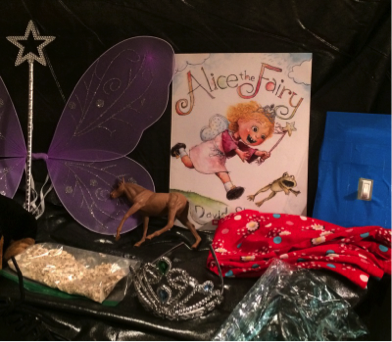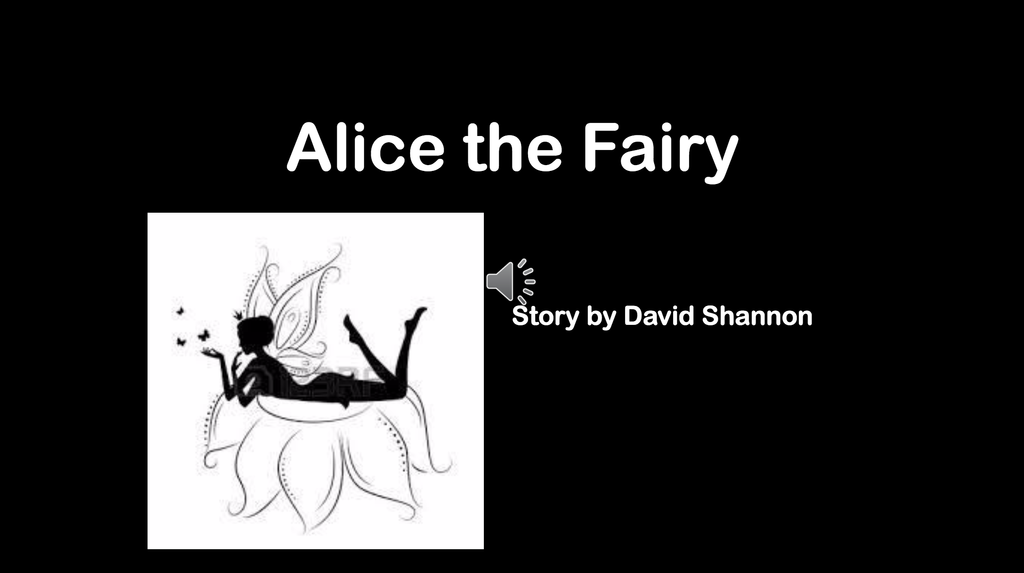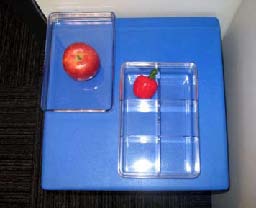As part of the graduate coursework for Visual Impairments and Multiple Disabilities in the Teacher Preparation Program in Visual Impairments at the University of Kentucky, students were asked to complete four projects: Story Box, Picture Communication Symbols for Story Box, Tactile Communication Symbols, and Talking Book Project.
We are sharing them on Paths to Literacy and hope that others will use them! Please add your comments at the bottom of the page.
- Story Box
- Picture Communication Symbols for Story Box
- Tactile Communication Symbols
- Talking Book Project
Story Box
I chose to do a story box for David Shannon’s book Alice the Fairy. In the story box, I included a magic wand, blanket, miniature horse, pants, leaves, real light switch, fairy dust, stuffed dog, tiara, magical water used to write her name and children’s life size fairy wings. As the story is being read, the student is able to explore the items that Alice magically changes along her quest to be a fairy.
Below is an explanation of the tactile objects and why I chose them:
- Wings: to illustrate a trait that fairies have. Students can wear the wings as the story is being read.
- Tiara: ALL fairies must wear tiaras! Student will be able to identify a tiara.
- Blanket: Alice uses the blanket as a cape to help her fly and also to hide underneath.
- Horse: Alice uses her fairy powers to change her dad from a frog to a horse.
- Pants: She uses imagery to describe her clothes on the floor and how they will magically hang in her closet.
- Leaves: Alice uses her magic want to make leaves fall from trees.
- Light switch: When Alice uses her wand to disappear, she flicks the light switch off.
- Fairy dust: It’s really oatmeal for fairy dust because I like the texture of it.
- Stuffed dog: Poor dog in the book is subject to Alice trying to cast a spell to have him float on the ceiling.
- Magic water: Made of clear gel in a Zip Loc bag. I chose to use this to illustrate Alice writing in water.
- Magic wand: Studentsso can use the wand to select choices for his/her answers to questions.
- Shoes: Black patent leather shoes are to illustrate the fancy shoes that Alice changed for her dad to wear.
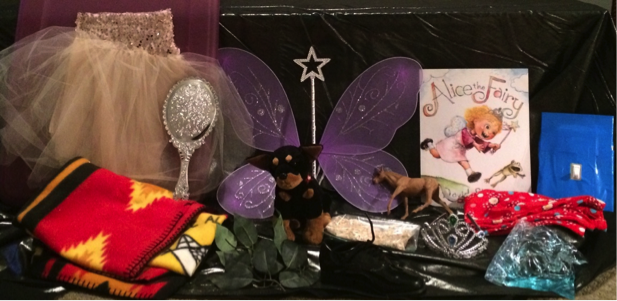
Background knowledge:
The background knowledge that students may need is using their imagination. A lot of times children have difficulty retelling stories or making up their own stories. This story really is about Alice’s day. The story tells how she is experiencing play with her dad, eating dad’s snack, thinking of how to dress him, playing outside in the leaves and water, turning the lights out, hiding under a blanket, playing with her dog, making a mess, getting timed out, eating dinner, taking a bath and cleaning up her room. Wow! All in one day. Also, students may have background knowledge on real leaves and horses.
Picture Communication Symbols for Story Box
After reading the story of Alice the Fairy, I would ask students comprehension questions based on the story. For each question, student will be given symbols to choose from. If there are too many symbols pictured at a time, I would cover all but 2-3 choices for the student or only place on a felt board.
-
Alice: I used a picture of a princess to illustrate the main character dressed with a tiara.
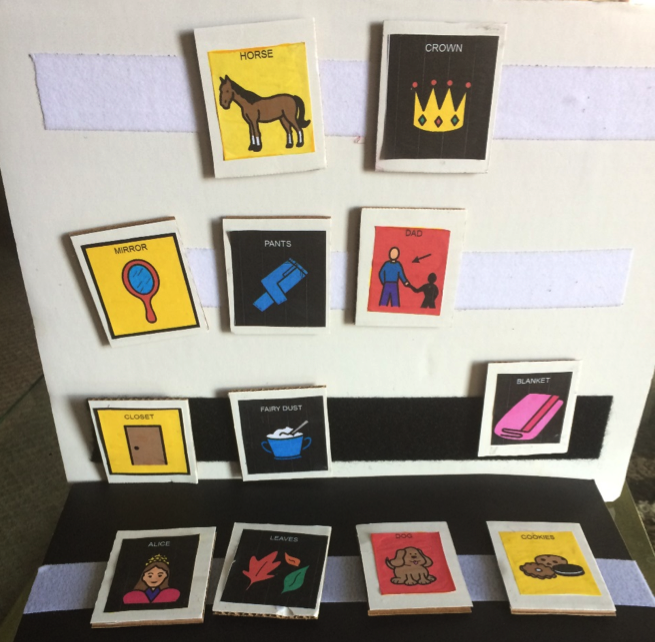
- Blanket: I used a picture of a blanket because Alice uses the blanket as a cape to help her fly and also to hide underneath.
- Horse: I used a picture of a horse to show how Alice uses her fairy powers to change her dad from a frog to a horse.
- Pants: I used a picture of a pair of pants to show how she uses imagery to describe her clothes on the floor and how they will magically hang in the closet.
- Leaves: I used pictures of leaves to represent Alice using her magic want to make leaves fall from trees.
- Cookie: I used a picture of cookies to represent cookies.
- Fairy dust: I used a picture of a bowl of sugar to represent how she used oatmeal for fairy dust.
- Dog: I used a picture of a dog to represent the dog in the story.
- Closet: I used a picture of hangers to represent a closet.
- Crown: I used a picture of a crown.
- Mirror: I used a picture of mirror.
- Dad: I used a picture of a dad with his child.
Background knowledge:
The background knowledge that students should have or working towards would be their experiences with cleaning their room like picking their clothes and hanging them in the closet, playing with a loved one. They should also know how or learning how to identify the main character and theme in a story.
Tactile Communication Symbols
After reading the story of Alice the Fairy, I would ask students comprehension questions based on the story. For each question, student will be given symbols to choose from. If there are too many symbols pictured at a time, I would cover all but 2-3 choices for the student or only place on a felt board.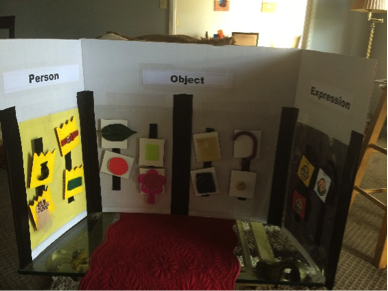

- Alice: sequence and tool material to represent a fairy.
- Blanket: I used a piece of a blanket.
- Horse: I used a piece of hair to represent the horse’s tail.
- Pants: I used a piece of blue jeans with the button and zipper to represent pants.
- Leaves: I used an artificial leaf.
- Cookie: I decided to use tactile paper to represent a cookie.
- Fairy dust: I used tactile paper to represent the texture of dust.
- Dog: I used a piece of my dog’s collar to represent a dog.
- Closet: I used the top of a clothes hanger to represent the closet.
- Crown: I used a top of an ornament to represent the crown.
- Mirror: I used a child size mirror.
- Dad: I used a green dish scrubber to represent dad’s beard.
Background knowledge:
The background knowledge that students should have or working towards would be their experiences with cleaning their room like picking their clothes and hanging them in the closet, playing with a loved one. They should also know how or learning how to identify the main character and theme in a story.
Talking Book Project
Some students may prefer to use a talking PowerPoint book to read along with the book, while listening to the audio version.
This talking book is based on Alice the Fairy by David Shannon.

